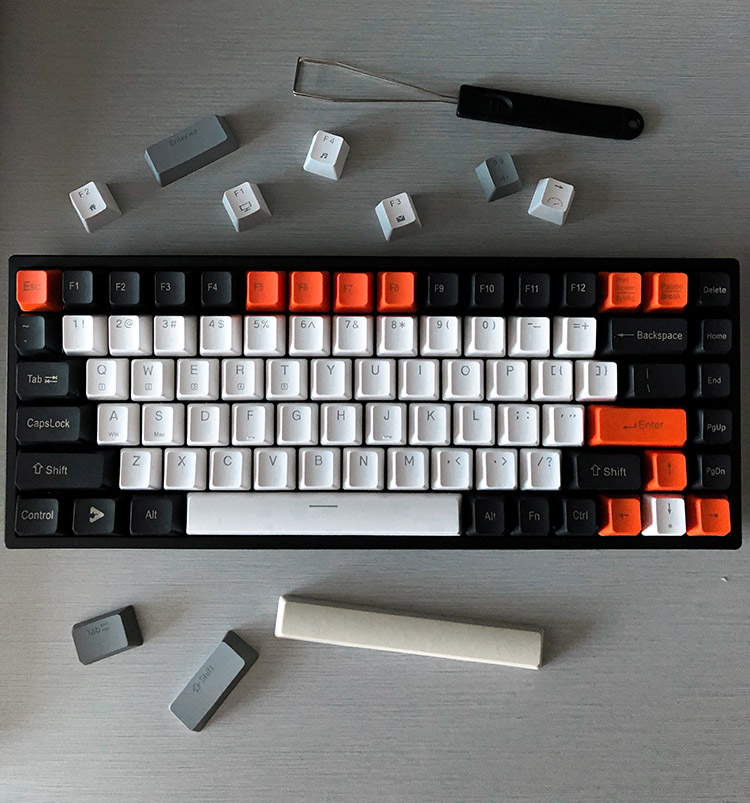You interact more with your computer via your keyboard than with any other interface, but for most of us we tend to just put up with what we’re given, whether that’s the keyboard on our laptops or the one that came in the box when we bought a desktop computer.
The reality for most of these keyboards is that while they’re functional, they’re also built as cheaply as possible, and they lack any semblance of individuality. That’s where the world of custom – or at least customisable – keyboards comes into its own, whether you’re after specific features or just to display a bit of your own personality on your own typing interface.
Customising a keyboard is rather akin to the way that some people love to customise cars, in that there’s a wide variety of approaches, from simple software-driven customisations – the equivalent of putting a few go-faster stripes on that old Datsun, all the way up to building the entire keyboard yourself, the “kit car” version of a custom keyboard.

All custom keyboards start with some level of mechanical keyboard. You might think that all keyboards are part of a machine and are therefore “mechanical”, but in this case it’s referencing the mechanism beneath each key on a keyboard. On most cheap keyboards there’s a simple membrane or scissor switch array that works across the whole keyboard, but a mechanical keyboard uses an individual spring-activated switch for each key.
This gives a direct tactile feedback to mechanical keyboards, as well as – in most cases – a more distinct sound, akin to that of a classic typewriter. Mechanical switches can be replaced when they wear out, but they can also be chosen and styled – and that’s where we start down the journey of custom keyboards. However, you can start quite simply if you just want a little pizzazz in your keyboard.
Simple Customisation: RGB lighting

The single biggest set of proponents of mechanical keyboards are the PC gaming crowd, and they’ve long been fans of customising everything to do with their gaming systems with RGB lighting. This is why you’ll find nearly every mechanical keyboard has RGB lighting enabled for every key on the keyboard.
While you’ll commonly see these reflecting some truly garish rainbow designs, that’s largely just to show off what’s possible for each key. Most common makes will incorporate RGB customisation software that allows you to set patterns, light intensity, and colours right down to individual keys. For many gamers that’s a question of highlighting their commonly used keys, but the sky’s the limit in terms of customising colours to suit your style or need.
Mid-level customisation: Switching it up
You can also take pre-built mechanical keyboards and change their hardware up in many circumstances. Because most (but not all, and it pays to check before you buy) mechanical keyboards use standard types of switches under each keys that can be replaced if they wear out, there’s also scope to swap out specific switch for given keys, or across the whole keyboard.
Here it’s useful to know a little bit about how switches are sold and marketed to get the feel that’s going to be best for you. Most manufacturers sell switches in three distinct types: linear, tactile or clicky. So, what’s the difference?
Linear switches offer mechanical precision with with a smooth key action and very little noise. If you don’t like the machine-gun style of a mechanical keyboard, then linear switches might be for you.
Tactile switches, as the name suggests, offer a little more tactile resistance and noise than linear switches. These keys need a little more force to actuate than a linear switch, but some users do prefer that.
Finally, if you want keys that crash down with a very distinct noise, then clicky is where you should look. As you might expect, clicky switches typically require the most typing force to register a press.

Most brands sell switches under colour definitions, with red being linear, brown being tactile and blue being clicky, but it’s worth checking the fine print to make sure you’re getting switches that will match up to your ambitions and desires.
Equally while you can generally mix and match switch types if you wanted, say, linear force on a space bar but clicky force on the function keys, it’s worth checking against the capabilities of your given keyboard to actually take these kinds of switch swaps. You’ll need to ensure that you’re buying a prebuilt keyboard that allows for switch swapping, as many models solder the switches in place, making this level of customisation impossible. Of course, that leads us to the third option:
Build it yourself: A keyboard for you, your way
If you want a keyboard that’s truly unique to you, it’s entirely feasible to build one yourself, picking out the exact keyboard size, chassis material, switch construction and keycap colours as you go.
Like the kit car industry, this can be a real rabbit warren of concepts and approaches, which can be massively liberating in terms of setting up a keyboard your way for you, rather than the rather sterile designs of most traditional keyboards. The choices are nearly endless, and unlike the kit car industry, you don’t have to prove roadworthiness before taking your custom keyboard onto the Internet.
However, depending on your level of customisability, it can be a challenging affair involving separate purchases of many parts, soldering, and testing and fine-tuning to get it working the way you want it to. Because you’re building it yourself, you’re also on your own when it comes to warranty issues for the most part compared to a pre-built keyboard. It’s also typically more expensive than nearly every available consumer keyboard, but that’s not entirely surprising, given that you’re buying parts in the singular where keyboard makers buy them by the millions.




